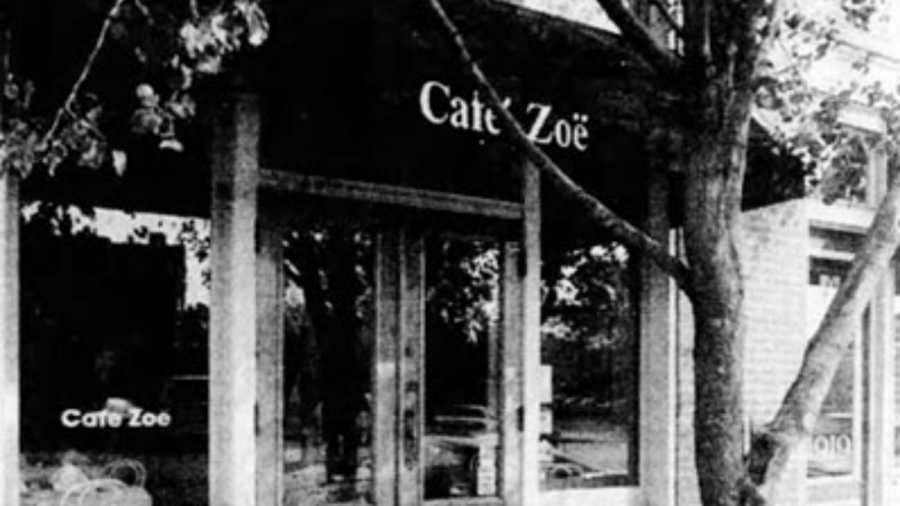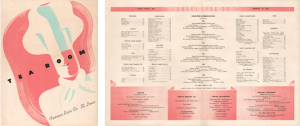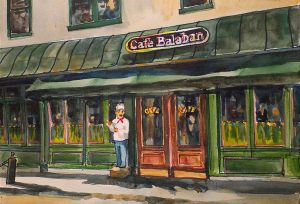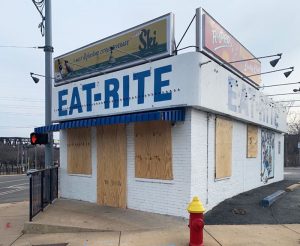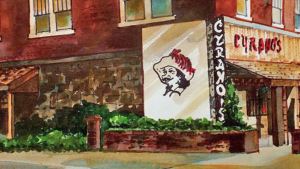Lost Tables : Remembering Cafe Zoe
Published October 10, 2021
Have you ever wondered what happened to that restaurant you once loved and have memories of dining at with your family and friends? We did! There is an amazing website called Lost Tables, dedicated to celebrating the restaurants of our past. We are partnering with the site’s creator Harley Hammerman and celebrating these wonderful stories. Hammerman and his wife Marlene are members of Shaare Emeth, and she is past president of the National Council of Jewish Women of St. Louis. Visit Lost Tables on Facebook
Zoe Houk grew up in Crestwood with two older sisters — Belinda, who would become an artist, and Carrie, who would become a producer and casting agent. Her mother, Billie, credited her husband, Jean, with their daughters’ inherent talents.
Houk’s father died from cancer when she was a young girl.
Houk’s mother admonished her daughters to “sustain themselves” and not rely on marriage in order to live. After graduating from Lindbergh High School, Houk attended classes at Meramec and Forest Park community colleges. Asked what she was studying in school, she responded, “Nothing. Going to make my mother happy.”
Houk’s first job as a waitress at age 18 was at The Loft in West County. From The Loft she went to H. Brown’s, a bar in the Central West End, as a waitress and underage bartender, with her sister, Belinda. Caleco’s and The Ladle followed, and at each restaurant she learned a little more about the business. In 1981, Houk moved on again to the Empire Cafe in Lafayette Square.
Beginning in the late 1960’s, a restoration movement took root in the Lafayette Square area. Many young couples moved into the neighborhood, buying old houses and renovating them. In 1972, Lafayette Square was declared a historic district by the city.
In May of 1980, Jill Mead and Susan Vaughn opened the Empire Cafe and Charcuterie at 1923 Park Avenue. Mead was in charge of the kitchen and Vaughn managed the business.
The Empire menu included soups, salads and sandwiches. The most popular item was the chicken salad. “We make 550 pounds a week and run out,” said Mead.
The creamy, all-white-meat chicken salad was so popular, it was available for takeout at both the Ladue and Wydown Markets.
Zoe Houk had waited tables at the Empire Cafe for about a year when she was pegged to manage Empire’s new venture, the Shell Empire Cafe, which opened in August of 1982 in the renovated Shell Building at 13th and Locust.
However, all was not well at the Empire, as Mead and Vaughn clashed over how to run the business. Vaughn was forced to withdraw from the enterprise in January of 1982, filing a lawsuit against Mead a year later. The turmoil led to the closure of the Lafayette Square restaurant in December of 1982, shocking the Empire’s enthusiastic customer base.
Zoe Houk, who was still managing Empire’s restaurant in the Shell building, was at the right place at the right time.
It was a fluke. I was working for these two women and they were highly successful. They hated each other and they wound up suing each other. And the restaurant closed.
That was right when Lafayette Square was just getting going and they really needed that restaurant there. It was helping build their community. John Ferring owned the building and told me he’d lend me the money to take it over. I think it was $18,000 but it felt like a million to me.
So it just worked out. I was 23 years old.
In February of 1983, Houk and her partner Steve Robinson took over the Lafayette Square space. Houk had met Robinson a few years earlier when the two were working at Caleco’s.
“We had to quit our jobs to work on the place,” Houk said, “so we practically had to live there.”
Cafe Zoe opened its doors June 1, 1983, four months later.
While the cafe was in essence the place that Jill Mead and Susan Vaughn had built, Houk and Robinson did manage to make the restaurant their own. An exciting and attractive dining space from the Empire days, the cafe became more sleek and less cute, losing its bay window.
They kept the stark white walls and invited local artists to hang their works in the bright showcase. Light from the storefront’s large windows played on the interior’s muted grays, charcoals and off-whites. Seating was available in two large rooms.
While the cafe was in essence the place that Jill Mead and Susan Vaughn had built, Houk and Robinson did manage to make the restaurant their own. An exciting and attractive dining space from the Empire days, the cafe became more sleek and less cute, losing its bay window.
They kept the stark white walls and invited local artists to hang their works in the bright showcase. Light from the storefront’s large windows played on the interior’s muted grays, charcoals and off-whites. Seating was available in two large rooms.
However, all was not perfect at the start. In the space of a week after opening, Houk fired both her chef and her restaurant consultant.
“We were too scared to make all the decisions ourselves, and probably afraid to rely on our instincts, but we realized right away that it wasn’t going to work. The menu wasn’t right, and the chef was into high-prep foods with sauces. We wanted things simple.
And I’ll tell you, if the chef and consultant had stayed, we wouldn’t have made it. Our concepts were totally different.”
Houk hired new cooks and redesigned the menu. One of those cooks was Ny Vongsaly who had worked with her at the Empire Cafe.
“He swam across the Mekong River with people shooting at him to escape to Thailand,” Houk explained of Vongsaly’s harrowing 1979 journey out of war-torn Laos.
Though never professionally trained as a chef, Vongsaly learned about food by watching his mother and sisters. He picked up their techniques and traditional Laotian recipes well enough to impress Houk and his other co-workers when they worked together at the Empire Cafe.
“Zoe would say, ‘Hey, this is what I want — salty, spicy big flavors,'” Vongsaly said, recalling how he would bring in traditional Laotian dishes for his colleagues. “They would all say that they wanted more of this for lunch.”
After a few months at Cafe Zoe, Vongsaly became the restaurant’s executive chef, creating a menu of dishes influenced by the food he’d grown up eating in Laos, as well as what he concocted while experimenting at home.
Vongsaly would eventually leave Cafe Zoe for Modesto, California, but would reconnected with Houk in 1998 in an enduring partnership that would take him to James Beard semifinalist status.
“Ny Vongsaly and I are like brother and sister,” said Houk, “except we don’t fight. We can complete each other’s sentences. We work on menus together, but he does all of the execution. We both have pretty good senses of humor so it’s a lot of fun and we get to eat! He is a wonderful chef and person. I could not be luckier to work with him.”
The Cafe Zoe menu expanded, including Houk’s longtime dream, Oriental Chicken Salad, and the dishes became more bountiful. Most of the changes were directed at attracting a new clientele — men in general, and business people in particular. As the Empire Cafe, the restaurant had a reputation as the kingdom of chicken salad and the mecca of the ladies who lunch. Houk began attracting a broader clientele.
Lunch was served Monday through Saturday. The lunch menu included soup of the day, two or three appetizers, five salads and seven entrees, some of which were sandwiches.
The chicken salad, which built the Empire Cafe’s reputation, remained on the menu. Whether ordered as a sandwich with homemade white bread or alone atop lettuce, it set the standard for chicken salad in the city.
Dinner was served on Friday and Saturday nights only. Entrees included broiled chicken sprinkled with rosemary and lemon juice, baked Cornish hen with apricot brandy sauce, chilled broiled beef tenderloin with mustard sauce, sautéed shrimp in pesto sauce, and broiled salmon filet with citrus butter. Salads, sandwiches and appetizers were carried over from the lunch menu.
Special dishes came and went and then came back again, if they were favorites. One that appeared periodically was asparagus wrapped in prosciutto and served with vinaigrette.
Click here to read the entire story of Cafe Zoe’s history on LostTable.com



